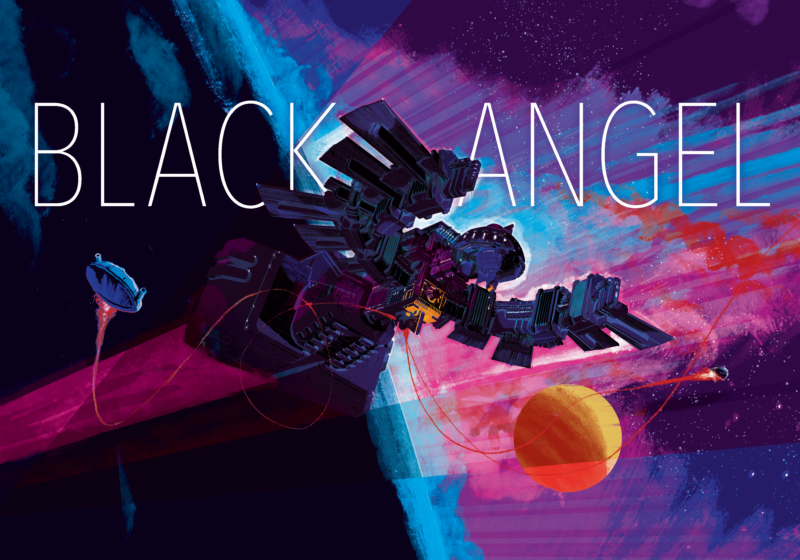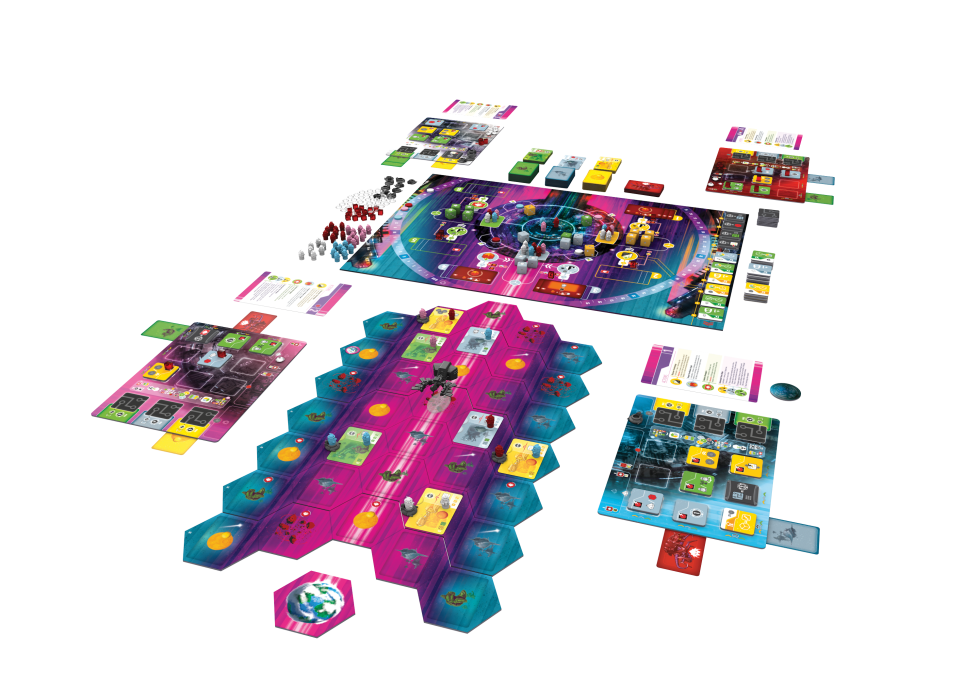
Black Angel reminds me of a pocket watch I once had. (This isn’t the setup to a bad joke.) You see, the watch was broken. A memento from my time in Germany, the watch broke during shipping and never kept good time, made a weird grinding noise when I wound it, and had an unsightly crack across its face. I still keep it around, though. With its open face and back, you can see the inner workings—gears, flywheels, jeweled pivots. The craftsmanship is breathtaking, even if it loses a minute every half hour.
Let’s back up. The board game Black Angel, designed by Sébastien Dujardin, Xavier Georges, and Alain Orban, is something of a spiritual successor to their previous collaboration, a well-known game by the name of Troyes. Like Troyes, Black Angel is a dice game in the loosest sense, tasking players with utilizing pools of dice in ways that are almost entirely novel. It also resembles a busted clockwork—lots of ideas working in sync—just not quite in sync enough to keep regular time.
Its first hurdle is the setting. Where Troyes was set in its namesake city and saw you overseeing the tried and tested (if overdone) theme of medieval tradespeople doing medieval things, Black Angel sets its sights somewhat higher. Literally. You’re located aboard a generation ship, see, on a 3,000-year voyage, right, and you’re one of a handful of competing artificial intelligences, OK, trying to be the best steward of the ship so you can become the only AI of the colony mankind will eventually settle, got it?
Huh. Cool, but huh.

Before you think that overseeing a generation ship for three millennia sounds tedious—all hydroponics metering and nitrogen adjustments—it turns out that space is crammed full of aliens who can relieve the tedium. Some of them want to trade with you. The ones that look like evil bugs want to attack you. And everyone has something you can use to secure the success of your mission.
What does gameplay look like? For the most part, it looks like picking up a die and taking an action with it. This seemingly straightforward process is more burdened with caveats and phases than it first sounds, but we’ll return to that in a bit. For now, your main worry is whether your chosen die has the right color and number. Colors correspond with different segments of the ship, while numbers increase the power of your action, letting you repair extra damage or research more technology. If you’ve rolled lots of stars—the game’s fancy way of dulling the edge of a fistful of zeroes—hopefully you have lots of minerals for buying dice from other players or for repurposed debris that lets you flip your dice to their opposite side. If you’re out of both dice and the means to purchase more, you’ll likely take a reset turn to gain more dice, clear off your personal board, and fly the Black Angel a little closer to its final destination.
Everything else in Black Angel is about taking this straight line of a concept firmly in hand, looping some bunny ears through a slipknot, and then winding the cord back and forth until you have three-quarters of a Gordian knot. The result doesn’t require Alexander the Great’s razor wit to untangle, but it’s snarled enough that you can expect to hear the occasional exasperated sigh.
Here’s an example. As the Black Angel passes through space, its trajectory takes you past myriad opportunities that are conveniently color coded to the dice on your ship. Let’s say you want to send out a drone to meet with some aliens. In order to do this, you begin running the preflight checklist. The right die, check. Sufficient droids—one to pilot the ship and one to undertake the mission—check. Speaking of which, a droid ship, check. Proper distance to an alien world, check. Remembering to add techs to the tech track and suffer additional evil-bug attacks on the Black Angel, because someone will absolutely forget to do this at some point, check. With all of these criteria ticked off, you can now doodle your droid ship over to an alien world, earn some points or resources, and perhaps set up some additional gains for later.
Best-laid plans
The trouble is, any number of things can go wrong along this path. Here are some possibilities.
One: somebody claims the die you need right before your turn.
Two: you buy somebody else’s die. This means they need to take a reset turn earlier than planned, which dumps the mission you just undertook off the edge of the board before you have a chance to trigger its benefits.
Three: you need a three-pip die but only two pips are available, so you use a card to activate one of the techs on your personal board to fly a little farther. Except now you realize you just spent the mission you wanted to undertake in order to undertake the mission, which is cool because it’s a sort of game-systems paradox, but very uncool because you can’t do the mission you’ve been hoarding all those debris cubes for.
Four: somebody has a die you could pay to flip to its three-pip side, but it’s illegal to both pay a mineral to buy a die and a debris cube to flip a die, because Dujardin, Georges, and Orban have constructed this clockwork universe so they can masquerade as cruel gods.
Five: you haven’t found any missions that are enticing. Plenty of them aren’t. Further, the need to constantly adjust your strategy based on not only the changing dice economy but also the temperamental nature of your cards tends to cause more start-and-stop than a traffic jam.
Six: as you move your droid ship to its destination, your friend Geoff remembers that he forgot to add evil bugs to the board. Turns out, the action you intended to take was assaulted by said evil bugs; your die’s three pips are actually two pips, and you need to lock a droid before you can access that action, but you only have the requisite two droids, and now you’re shouting “what the hell?” at Geoff. And rightfully so.
In practice, Black Angel does produce climactic turns. It’s just that they’re rare. Far more often, this is a game of building action, building action, sudden setbacks, building action, and then a slide whistle. Every so often, a bike horn tootles in the distance. Then it’s back to the slow churn of semi-optimal moves and incremental point gains.
This isn’t to say Black Angel can’t be gratifying. At its best, you’ll activate a string of technologies all at once, buy a die to clean up the ship or blast off on some lucrative mission, and then insert what you’ve gained back into your personal engine to unlock more stuff or endgame bonuses. When Black Angel’s interlocking parts slide into place, you feel like a watchmaker hunched over a workbench, forceps laying components into their proper places just so, a master of your craft, and surely Bürgermeister Glashütte will take notice of you at the annual clock fair!
Sadly, that’s the exception. There’s some elegance to the way all those segments interlock—expeditions and resources and evil-bug attacks and the dice economy—all feeding into one another. More’s the pity that they don’t fit more smoothly, that the game’s processes are counterintuitive and riddled with clarifications, that these gears grind rather than running as though on gravity alone. In the end, like my broken pocket watch, Black Angel is easier to respect than to enjoy.
"Review" - Google News
June 20, 2020 at 09:45PM
https://ift.tt/37JYcnc
Black Angel review: Run your own tabletop “generation ship” - Ars Technica
"Review" - Google News
https://ift.tt/2YqLwiz
https://ift.tt/3c9nRHD
Bagikan Berita Ini















0 Response to "Black Angel review: Run your own tabletop “generation ship” - Ars Technica"
Post a Comment